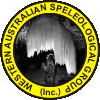By Rauleigh Webb
Minimal Impact Caving Code (MICC)
The MICC was accepted 12 months ago at the ASF conference in Victoria. From my personal experiences it appears that attitudes have changed very little during the past 12 months. Cavers are still exploring, new, extremely low energy cave systems with techniques reminiscent of the 1960's.
It is clear that ASF members have either not read the MICC or do not believe that it is necessary. I urge you to re-examine your personal caving techniques and to think carefully about MIC techniques.
During 1996 copies of the MICC and the Code of Ethics will be printed as a brochure on water proof paper and distributed to clubs. The costs will be borne by a donation specifically for this purpose.
Cape Range Marina
This marina has been modified from the original proposal and work will commence on this normal mole type marina in 1996. The limestone for the construction of the marina will come from the proposed limestone quarry discussed elsewhere in this report.
This project has the "green light" and will proceed. The impact of the marina on the karst is thought to be minimal, however the impact of the limestone mine to produce the material for construction of the marina is likely to be significant.
Cape Range Limestone Mine and Quicklime Plant
A public environmental review on the proposed Limestone Mine, Quicklime Plant and Shiploading Facility at Exmouth, WA was put out for public comment in October 1995. Comments were received by the EPA until 4 December 1995.
The ASF provided a submission making the following three major points:-
- The Federation suggests that the environmental impacts at the proposed site are likely to be considerable and that an alternative site should be selected at the nearby Rough Range.
- The Federation considers that a plan of action should be established for those instances where caves are intersected during mining activities. This plan should ensure that the resources of the intersected cave are fully qualified so that a qualitative decision whether to proceed can be made before mining of the cave commences.
- The Federation recommends that a comprehensive quarry rehabilitation plan is produced prior to the granting of any mining approval.
This issue is likely to be a major one in 1996.
Leeuwin-Naturaliste National Park
Permit System
The permit system continues to operate smoothly. Considerable work has been done to draft a system for the assessment of the cave leaders currently within the system (472 registered leaders (not in caving clubs) as at November 1995). It is planned to open the draft proposal for public comment early in 1996 and attempt to have the first leaders assessed by August/September 1996. This is dependant upon the proposed assessment panel being given the infrastructure support of a government agency. Conservation and Land Mangement (CALM) who is the agency with the responsibility for the majority of caves has been approached.
Track/Pathway Development and Restoration Work
Monies gathered from the permit system have been allocated to the major caves or areas within caves of highest priority. A major stairway has been constructed in Calgardup Cave which will halt the destruction of the entrance slope. Considerable restoration work will be required to attempt to repair this damage.
An abseiling platform is also planned for the temporarily closed solution pipe at Calgardup Cave. Once the platform has been constructed the pipe will be reopened for abseiling.
Considerable restoration and track marking had been undertaken in Bride Cave. A massive area of flowstone was washed to remove footprints and stringlines were put in place to dissuade visitors from repeating the damage. A number of walls were constructed to halt the slide of boulders into the cave. Trails were clearly defined and some areas barricaded. Information signs were placed in the cave to inform visitors about the trail marking. Further restoration work is being conducted in the sand chamber of the cave.
Lake Cave - Proposed Interpretive Centre
The Interpretive Centre at Lake Cave is to be called CaveWorks. Construction of the centre will commence in early 1996 with a proposed opening of mid-1996. This centre will provide a massive increase in caver/cave leader education facilities.
Nullarbor World Heritage Listing
The change of government has placed the proposed listing in limbo. No new developments have occurred since the WA liberal government was elected. Same status as 1994.
South Coast Management Plan
As at December 1995 none of the proposed National Parks or reserves in the Nullarbor region have been declared. The required legislation is STILL LOST (I have stated the same thing for the last 2 years!) in government mumbo jumbo!
No on site management is proposed for the parks and reserves in the Nullarbor region.
The Nullarbor region is coming under considerable pressure from cavers and cave divers from all over Australia and the world. The implementation of sensible on-site management is desperately required if the fragile cave systems of the Nullarbor are to survive in the condition they are today. This is further emphasised by the massive increase in the rate of finding new Nullarbor caves. The number of features has doubled since 1994. This increase is the result of the use of "planes" to locate caves (Plane Caving) as well as the numbering of small rock holes.
Yanchep National Park
Only two meetings of the Yanchep National Park Cave Management Advisory Committee were held during 1995. Crystal Cave has been leased, for a second time, to a private operator. CALM is still classified as the cave manager but the tour operations are conducted by private operators.
A major cleanup was conducted in Crystal Cave just prior to the granting of the lease. Considerable quantities of wood, concrete and other rubbish was removed from the cave. Lampenflora on decorations was removed.
Nambung National Park
The draft plan was released for public comment until the 15th December 1995. The Federation submitted a letter requesting an extension until the end of 1995 which was granted. A submission was made to CALM on behalf of the federation. The major recommendations that were made (complete submission, 21 pages including draft IUCN Cave and Karst Management summary, available on request) were:-
The Federation proposes the alteration of the recommendations from Section 5 of the draft Nambung National Park management plan to read:-
1. Consider the vulnerability of geological features, landforms and soils in all management operations, such as new access, firebreaks, fire management plans, catchment alterations and site developments.
2. In consultation with speleological groups, complete a resource inventory, classification system and access policies for caves and karst features in the area.
3. Liaise with speleological groups and other karst management specialists regarding management and other operations that are likely to impact on karst features.
The Federation proposes the following additional recommendation for Section 6, Hydrology:-
Consult with other government agencies and adjacent land owners to devise land use agreements to ensure the long term conservation of river catchments.
The Federation proposes that the following additional recommendation be added to Section 11 under Prescribed Burning:-
3. Burn Plans will contain edge burns at identified cave and karst sites that are considered highly vulnerable to damage from fires.
The Federation proposes that an additional recommendation be added to section 13 Introduced Plants and Animals:-
3. Sensitive cave and karst sites will be monitored for introduced species and eradicated as soon as practicable.
Other comments were that the overall plan does not attempt to manage the Nambung National park as a karst area but rather as individual non-related features.
Mt Lesueur National Park and Coomallo Nature Reserve
The final plan was released in late 1995 after submissions closed for the draft on 9th October 1994. The submission made by the Federation proposing that an adjoining (by one common boundary) National Park (Drovers Cave) be included in the plan was rejected by CALM. The proposal to examine the Mt Lesueur National Park for further caves and to classify and inventory all of the features was accepted and included in the plan.
Land Clearance adjacent to Drovers Cave National Park
This issue has just come to my attention and a submission for the Department of Environmental Protection is being prepared. This document will be updated once the submission has been completed.Briefly the proposal is to clear 873 hectares of land in the catchment of Old River Cave. This is likely to have a very detrimental effect on the hydrology of the cave and cleared wetlands.
Draft IUCN Guidelines for Cave and Karst Protection
Finally I cannot finish the 1995 report without comment on the excellent IUCN Guidlines for Cave and Karst Protection prepared by John Watson of CALM, Dave Gillieson of ADFA, Elery Hamilton-Smith and many speleologists whose comments were added to the draft. These guidelines will be of great assistance to many government departments whose knowledge of caves and karst is minimal but who have the task of managing such resources. These guidelines are available on the WWW at:-

